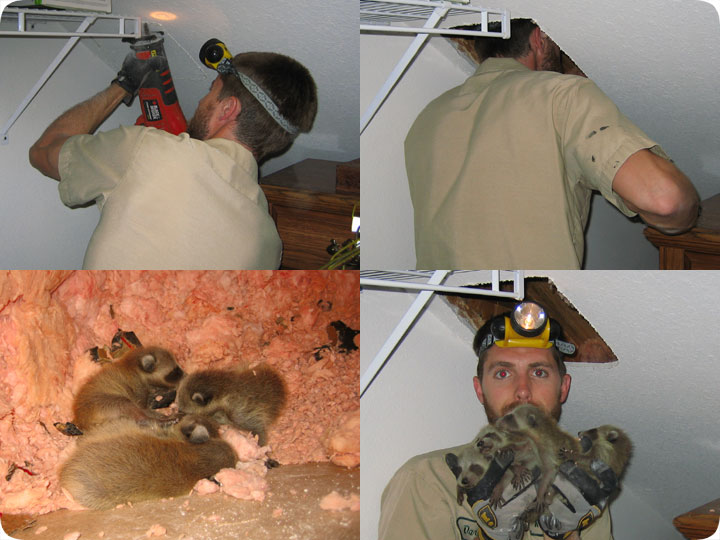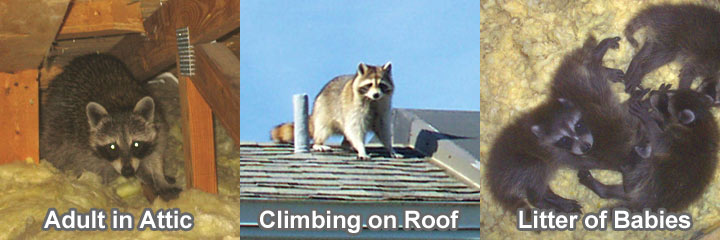Raccoons very frequently create a nest inside attics and trees. The females usually have 3-5 young per litter. The nesting season is usually in
spring, with peak time for birth in March, and the babies are often noticeable in April. However, nesting season varies depending on what part of
the country the raccoon lives in. Down south, they might give birth any time of the year, even though spring is still the most common time.
If you have a nest of baby raccoons in your house, such as in the attic or ceiling, they must usually be removed by hand. You can't set traps
for such little animals - they will just stay in the nest, nursing from the mother raccoon, until they are at least 3 months old, at which point
they might start to exit the nest to start foraging. You can't just trap the mom raccoon and leave the babies in the nest to starve and suffer to
death. You've got to remove them by hand, such as in the below photo:

Raccoons and nests -
A raccoon will build a bed just like most creatures, and a raccoon inside of a home is probably looking to have a family. A raccoon is not picky about what it uses for a nest. Outside, the most common material used are long grasses and hay, though the creature is smart enough to cart fabric remnants back to a den location. Raccoon inside of a home are far more at ease. Insulation provides amazing comfort and warmth, and a raccoon will shred the material until it generates enough of a pile to burrow within. When it comes time to give birth, a mother raccoon in a home will be far more at ease than one outside. This is why most invading raccoons are female. If you’re going to remove the adult, you need to do a thorough search for young. There is almost always a cluster of kits somewhere in the home. If you’re uncertain of their whereabouts, wait until nighttime and listen for squeals and soft sounds. It’s difficult to tell a raccoon nest from other animals’ if you don’t have a trained eye. A squirrel nest might be just as large; however, a squirrel nest tends to be more intricate than that of a raccoon.
NEED LOCAL HELP? We have wildlife removal professionals servicing 95% of the USA. Click here to
hire a local raccoon removal expert in your home town. Updated 2018. But read the below advice first!

How do I know if the raccoon in my attic has had babies -
If you can’t find out for certain, it’s always best to assume the raccoon in your attic had babies somewhere in the building. Most of the adult raccoons that enter a building are females with the idea in their head to have a family. That’s not to say you won’t occasionally encounter a male raccoon in the attic, but females offer their own challenges when it comes to removal. If you’re able to get close enough to the raccoon to see it clearly, try to discern protruding nipples on its belly. This is a sure sign the animal has young. Beyond that, unless you’re a professional who can tell a female raccoon just by looking at it, you’re going to have to guess. Trapping a raccoon in your home is often illegal depending on where you live. Because of the potential complication of babies in the attic, calling in a wildlife removal company isn’t unreasonable. Not only will the professional be able to trap the adult, if there are any babies in the space, the expert will be able to find and remove them, too.
Raccoon nesting habits - The main criteria is a safe place, safe from predators and the elements. Trees are great, as are attics. The mother will scout around in its territory, looking for a good spot
in which to give birth. During this phase, they will often tear open holes in roofs of houses. Once inside, or in any safe place, they will just find a suitable spot. Raccoons don't build nests, like
birds and squirrels do. They don't really bring in nesting debris like sticks or leaves. They do, however, leave their waste near the nesting area, and all around the attic. If you want to see photographs, click here for raccoon droppings and feces identification.
Raccoons and their young -
Most people who have a problem with a raccoon in the home have a raccoon that is female. That’s not to say a particularly bad winter won’t drive male raccoons into an attic, but most of the time the pest up there is a mother-to-be, and she's getting ready for nesting season.
In nature, male raccoons kill litters that are not theirs. This throws the female into another heat cycle and allows that male to breed her. It’s a sad cycle, and female raccoons are all too aware of the danger males mean to their babies. Because of this, a
female raccoon will often leave her normal territory to find a place safe. There are few places as protected from the weather and predators as is a human house. Once the female bullies her way inside she’ll set out to make a nest. This nest is going to be made
of insulation and anything else she can tear off the walls of your home. Usually, though not all the time, the nest will be inaccessible to you, down inside of a wall or tucked into an eave. Getting the babies out is just as important as getting out the adult.
Often, you can use the babies to lure the mother into a cage trap if you can get the litter nest of baby raccoons out of the attic first.
If you find a baby raccoon nest in a tree, it's no cause for alarm. I say, just let 'em be! Unless they are causing you any specific damage or problem you don't want, leave them alone. If you do want to remove them, be sure you
catch and remove them all together, the mother plus the juvenile racccoons, so that the mother can care for the young after you relocate them. You can set a trap at the base of the tree for the adult, and them remove the nest from the
tree by hand, and put them in an animal carrier, and bring them all to the same place when it's time to let them go. Hopefully, the mother will find a new tree.
Raccoon nesting box - you can help out by building a nest box for raccoons. Any wooden box, at least two feet wide, with an opening of at least 6 inches, will do. It must be off the ground,
preferably in a tree. That'll help out raccoons a great deal.
However, to be honest, and this is coming from a raccoon lover, I'm not sure they need the help. There are so many raccoons in cities now, it's crazy! One more good nesting area will only increase the population.
Click here to learn everything about how to get rid of raccoons in the attic, from the web's best guide.
guy listed in Cleveland on my directory of professionals. He'll do a good job.